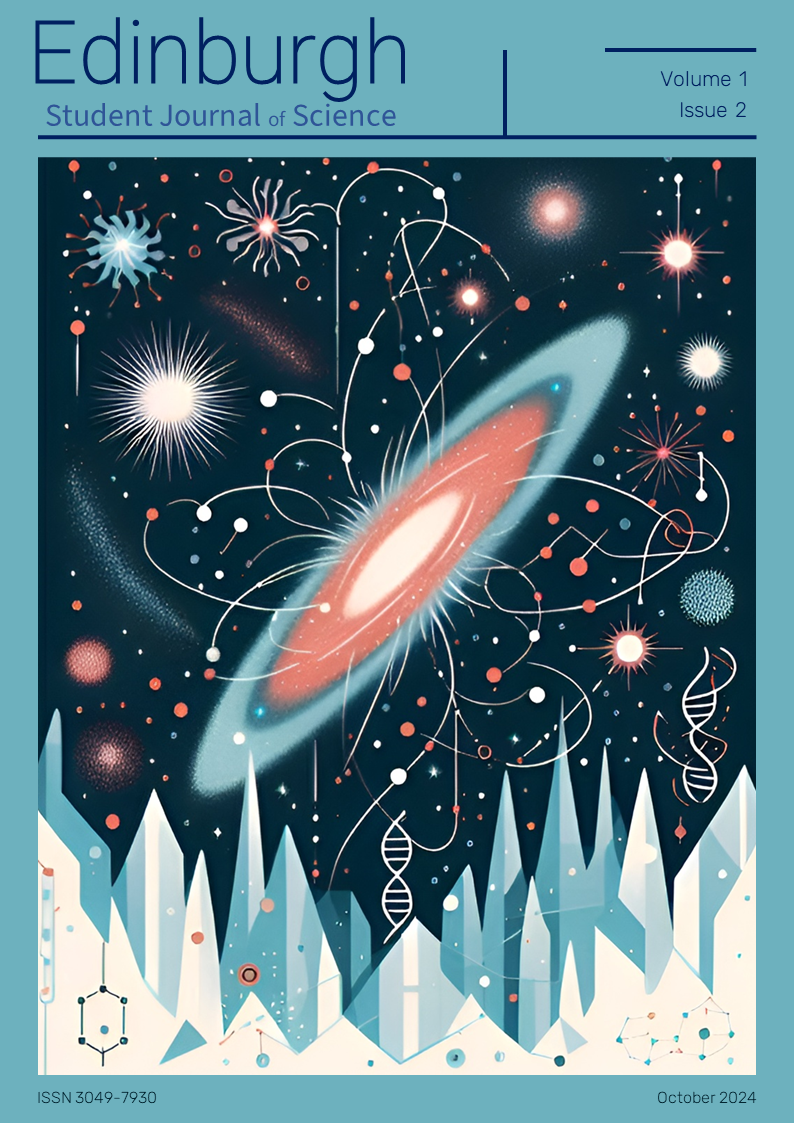A JWST Pure-Parallel Search for the First Galaxies With PANORAMIC
DOI:
https://doi.org/10.2218/esjs.9993Keywords:
Photometry, Redshift, JWST, Galaxy EvolutionAbstract
The James Webb Space Telescope offers unparalleled capabilities for observing the most distant objects in the universe, allowing us to study the first galaxies to form. In this work, the Lyman-break technique and spectral energy distribution fitting were used to analyse the JWST PANORAMIC survey and identify 26 robust galaxy candidates at redshifts greater than 9.5, including three around redshift 14.5. These candidates will make excellent targets for follow-up spectroscopy. The derived UV luminosity function at z = 14.5 is consistent with literature determinations at similar redshifts and implies a modest evolution in the number density of galaxies from z ∼ 14 to z ∼ 11. Future research based on this work could determine when the first galaxies formed, confirming or challenging current theories of cosmic evolution.
Downloads
References
Arnouts, S. and Ilbert, O. ‘LePHARE: Photometric Analysis for Redshift Estimate’ Astrophysics Source Code Library (2011)
Arrabal Haro, P. et al. ‘Confirmation and Refutation of Very Luminous Galaxies in the Early Universe’ Nature 622 7984 (2023)
Bertin, E. and Arnouts, S. ‘SExtractor: Software for Source Extraction’ Astronomy and Astrophysics Supplement Series 117 2 (1996)
Bouwens, R. et al. ‘UV Luminosity Density Results at z > 8 From the First JWST/NIRCam Fields: Limitations of Early Data Sets and the Need for Spectroscopy’ Monthly Notices of the Royal Astronomical Society 523 1 (2023)
Carniani, S. et al. ‘Spectroscopic Confirmation of Two Luminous Galaxies at a Redshift of 14’ Nature 633 (2024)
Castellano, M. et al. ‘JWST NIRSpec Spectroscopy of the Remarkable Bright Galaxy GHZ2/GLASS-z12 at Redshift 12.34’ The Astrophysical Journal 972 2 (2024)
Conroy, C. ‘Modeling the Panchromatic Spectral Energy Distributions of Galaxies’ Annual Review of Astronomy and Astrophysics 51 1 (2013)
Donnan, C. T. et al. ‘The Evolution of the Galaxy UV Luminosity Function at Redshifts z ∼ 8−15 From Deep JWST and Ground-Based Near-Infrared Imaging’ Monthly Notices of the Royal Astronomical Society 518 4 (2023)
Donnan, C. T. et al. ‘JWST PRIMER: A New Multi-field Determination of the Evolving Galaxy UV Luminosity Function at Redshifts z ≃ 9 − 15’ Monthly Notices of the Royal Astronomical Society 533 3 (2024)
Dunlop, J. S. ‘Observing the First Galaxies’ in The First Galaxies: Theoretical Predictions and Observational Clues (Springer Berlin Heidelberg; 2012)
Harikane, Y. et al. ‘A Comprehensive Study of Galaxies at z ∼ 9 − 16 Found in the Early JWST Data: Ultraviolet Luminosity Functions and Cosmic Star Formation History at the Pre-reionization Epoch’ The Astrophysical Journal Supplement Series 265 1 (2023)
Harikane, Y. et al. ‘Pure Spectroscopic Constraints on UV Luminosity Functions and Cosmic Star Formation History From 25 Galaxies at zspec = 8.61 − 13.20 Confirmed With JWST/NIRSpec’ The Astrophysical Journal 960 1 (2023)
Harikane, Y. et al. ‘JWST, ALMA, and Keck Spectroscopic Constraints on the UV Luminosity Functions at z ∼ 7 − 14: Clumpiness and Compactness of the Brightest Galaxies in the Early Universe’ arXiv e-prints (2024)
JWST ‘NIRCam Filters - JWST User Documentation–Jwst-docs.stsci.edu’ Accessed 19th Sep 2024 (2017)
McLeod, D. J. et al. ‘The Galaxy UV Luminosity Function at z ∼ 11 From a Suite of Public JWST ERS, ERO, and Cycle-1 Programs’ Monthly Notices of the Royal Astronomical Society 527 3 (2023)
Pacifici, C. et al. ‘The Art of Measuring Physical Parameters in Galaxies: A Critical Assessment of Spectral Energy Distribution Fitting Techniques’ The Astrophysical Journal 944 2 (2023)
Regan, M. ‘Detection and Flagging of Showers and Snowballs in JWST’ JWST Technical Report; Accessed 17 Sep 2024 (2024)
Williams, C. C. et al. ‘The PANORAMIC Survey: Pure Parallel Wide Area Legacy Imaging With JWST/NIRCam’ arXiv e-prints (2024)
Downloads
Published
Issue
Section
License
Copyright (c) 2024 Hanna Golawska, Derek McLeod

This work is licensed under a Creative Commons Attribution 4.0 International License.




